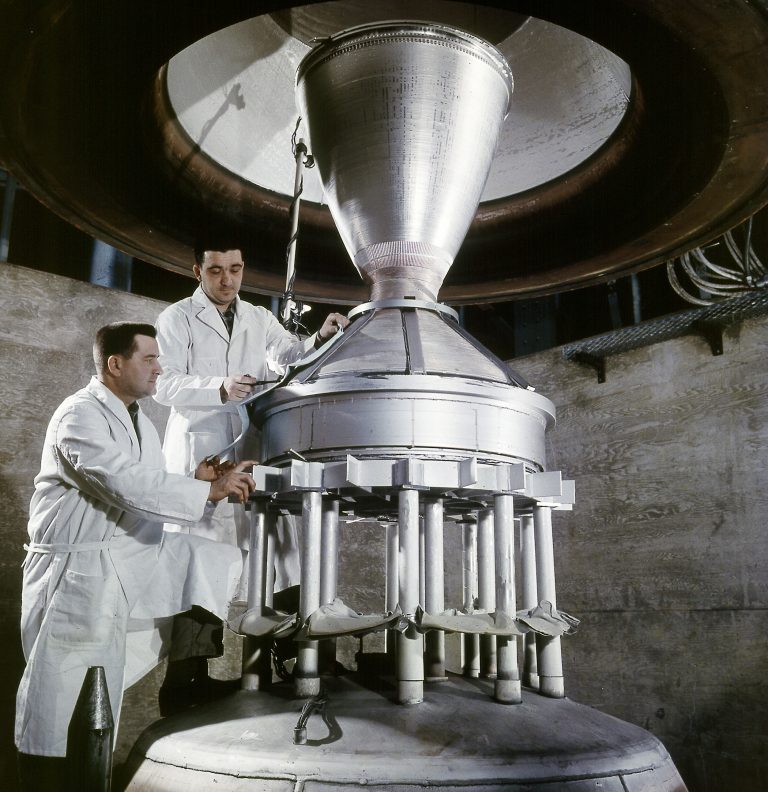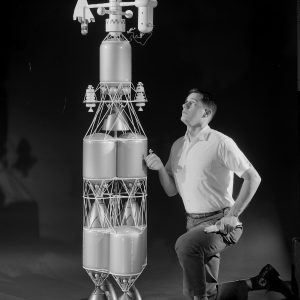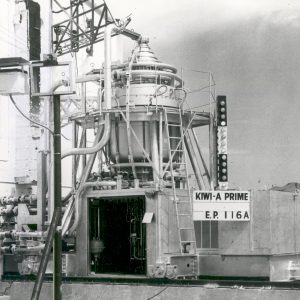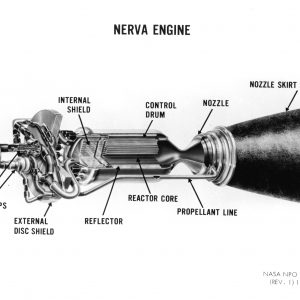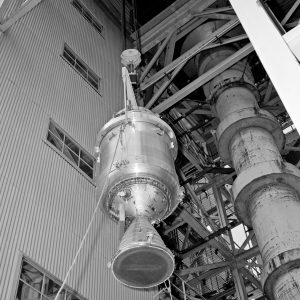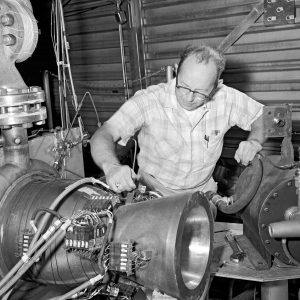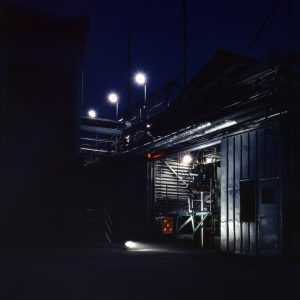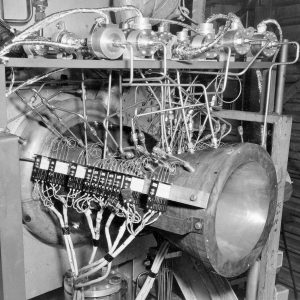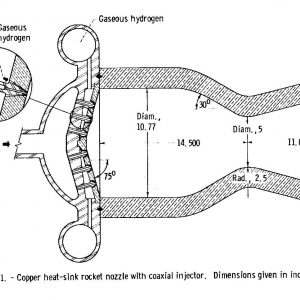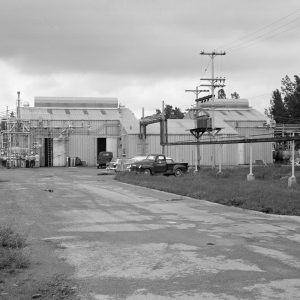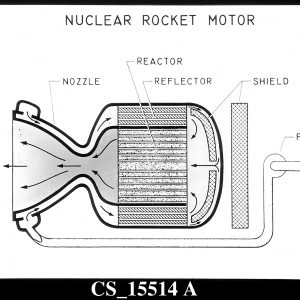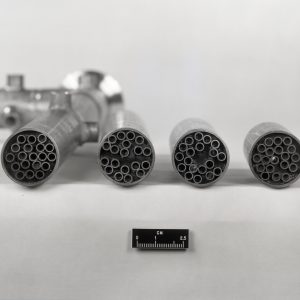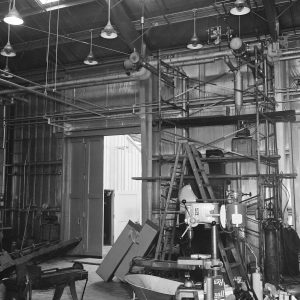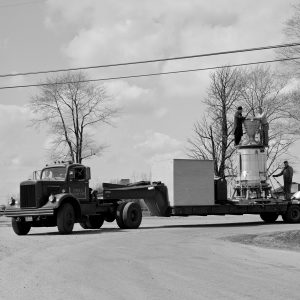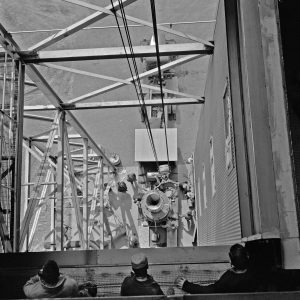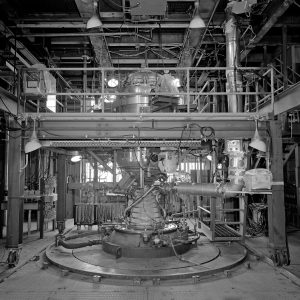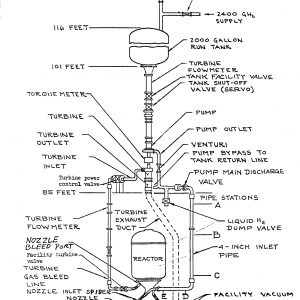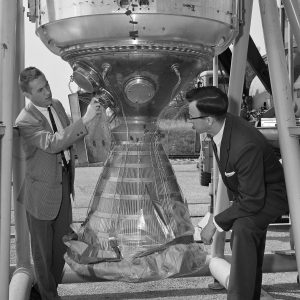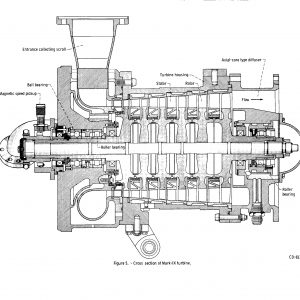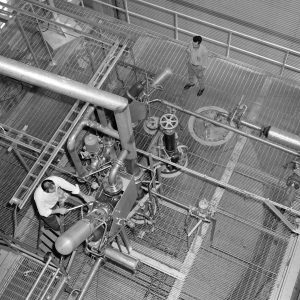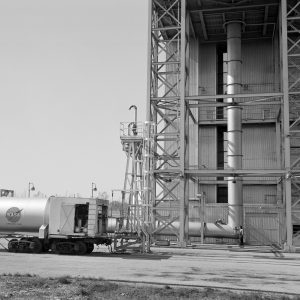Nuclear Rockets
The Nuclear Engine for Rocket Vehicle Applications (NERVA) was a joint NASA and Atomic Energy Commission endeavor to develop a nuclear-powered rocket for both long-range missions to Mars and as a possible upper-stage for the Apollo Program.
Los Alamos possessed the primary test facilities in Nevada and New Mexico, but NASA’s Lewis Research Center had been involved from the start with both the design of the engine’s reactor and the liquid-hydrogen fuel system, particularly the turbopump which pumped the fuels from the storage tanks to the engine and was the primary tool for restarting the engine in space.
Project Rover and NERVA Programs
After World War II, engineers became interested in utilizing the massive power of atomic fission for aircraft and missile propulsion. In 1945 the military began sponsoring efforts to develop an atomic aircraft. Engineers, however, could not overcome issues involving the required shielding for the crew or the fear of radiation at crash sites. In 1955 the military partnered with the Atomic Energy Commission (AEC) to develop reactors for nuclear rockets under Project Rover. The nuclear rocket would be an upper stage not fired until it entered space—reducing the threat of crash-induced contamination on Earth. The nuclear rocket would use fission to heat liquid-hydrogen and expel it as thrust at rates that would supersede those of chemical rockets.
In 1959 NASA replaced the Air Force in this role, and the mission changed from a nuclear missile to a nuclear rocket for long-duration space flight. The Rover program began with research on basic reactor and fuel systems. This was followed by a series of Kiwi reactors built to test nuclear rocket principles in a non-flying nuclear engine. The next phase, the Nuclear Engine for Rocket Vehicle Application (NERVA), sought to develop a flyable engine. The final phase of the program, called Reactor-In-Flight-Test, would be an actual launch test.
The AEC worked to develop the reactor for the engine at its facilities in New Mexico and Nevada, and Lewis concentrated its efforts on the vehicle’s liquid-hydrogen system. The Rocket Systems Area provided resources to conduct basic research on nuclear engine systems and to test hydrogen pumping systems. A series of 300-megawatt Kiwi-A reactors were tested at the Nevada Test Site in 1959 and 1960. The Kiwi-B reactors, which dramatically increased the power without increasing the overall size, were tested between 1961 and 1964.
Aerojet was simultaneously incorporating one of the Kiwi-B reactor designs into its NERVA NRX (NERVA Reactor Experiment) engine. The first NERVA NRX test was run in September 1964 in Nevada. In 1969, the AEC successfully tested a second-generation NERVA engine, the XE, dozens of times. Funding for NERVA, however, decreased in the late 1960s and the program was cancelled in 1973 before any flight tests of the engine took place.
Documents
- To the End of the Solar System: The Story of the Nuclear Rocket
- NERVA Nuclear Rocket Program (1965)
- A Historical Perspective on the NERVA Program (1991)
- Overview of Four Rover Engine Tests (1991)
Nozzle Cooling
Nuclear rocket engines ae designed to operate at extremely hot temperatures to maximize efficiency. The regenerative cooling system, which flows cold liquid hydrogen through tubes surrounding the nozzle, is an essential element of the design. Unlike chemical rockets, nuclear engines employ a nozzle that narrows sharply before expanding. It was difficult to cool the contraction area. To address this problem, Lewis researchers sought a better understanding of the heat transfer process in the nozzle. They installed experimental copper and steel engines in the J–1 test facility at Plum Brook Station [today, the Neil Armstrong Test Facility]. The researchers used the test results from numerous firings of the engine to create a mathematical formula to predict the transfer of heat from the exhaust to the nozzle. They then expanded the investigation by firing the engine with different propellants and injector shapes. The studies at J–1 determined that the injector design needed to be tailored to the shape of the nozzle.
Reports
- Investigation of Hot-Gas Side Heat Transfer (1965)
- Hot-Gas-Side Heat Transfer in Hydrogen-Oxygen Rocket (1971)
- Hot-Gas-Side Heat Transfer with/without Film Cooling (1972)
- Coolant-Side Heat Transfer Rates for Rocket (1973)
Cooling the Moderator
Nuclear rocket engine designs included a moderator that used water to slow down fast-moving neutrons. This improved the efficiency of the reactor fission. A heat exchanger cooled the moderator by transferring the heat from the moderator’s water to the cryogenic liquid hydrogen. The exchanger was a tube within a tube. The hot moderator water flowed through the inner tube, and the cold hydrogen flowed through the outer tube. The formation of ice on the heat exchanger’s surface posed a potential problem, particularly when the propellant supply was low. The ice could degrade the exchanger’s performance and could potentially block the flow passages. In response, Lewis undertook a multiyear effort to measure the ice levels and study the conditions that created the ice.
The researchers installed a triangular 19-tube heat exchanger between the Hydraulics Laboratory’s (F Site’s) two hydrogen supply tanks to determine whether ice buildup varied on each of the tubes. They flowed the hydrogen and water through the system in opposite directions first, then in the same direction. The tests verified their predictions for conditions without ice formation, but their estimates for when ice was present proved to be significantly low.
Documents
B-1 Test of an Axial-Flow Pump
Nuclear rocket engines must be able to vary its speed and restart its engine without any external power to carry out long-duration human missions to other planets. Similar to chemical rockets such as Pratt & Whitney’s RL–10, the nuclear engine would release a small amount of hydrogen to power the turbopump’s turbine. The turbine would activate the complete pump, which would supply fuel to the combustion chamber. NASA used the High Energy Rocket Engine Research Facility (B–1) and Nuclear Rocket Dynamics and Control Facility (B–3) test stands to study this process for Kiwi reactor designs.
In 1964 and 1965 Lewis conducted a propellant system program at B-1 to study different types of nuclear rocket cycles in an unfueled Kiwi B–1B reactor equipped with a Rocketdyne Mark IX axial-flow turbopump. The propellant was pumped through the rocket system as during a normal startup, but the engine was not fired. The researchers first tested the system over a range of flow conditions to obtain data on the engine controls, fluid instabilities, and heat transfer during the startup period.
The B-1 runs determined that the turbine could achieve bootstrap acceleration during flow initialization. The AEC also successfully demonstrated shortly afterwards at Los Alamos. Further B-1 studies in early 1965 showed that the Mark IX turbopump accelerated as needed and did not stick. The separation of flow from the nozzle surface resulted in a large amplitude vibration in the nozzle.
Documents
- Nuclear Rocket Evaluation at B-1 Memo (1962)
- B-1 NERVA Apparatus Description (1964)
- Flow System Startup of a Full-scale Nuclear Rocket (1965)
- Nuclear Rocket Simulator, Flow Initiation with No Turbine Gas (1964)
- Nuclear Rocket Simulator Tests, Flow Initiation(1964)
- B1 NERVA Start Up Dynamics and Control (1966)
- Cooldown of Regenerative Nozzle in Nuclear Rocket Facility (1967)
B-3 Testing of Centrifugal Pump
Lewis then sought to study the Kiwi B-1B start up using an Aerojet Mark III centrifugalturbopump at the B-3 stand. The B–3 tests, which ran from March to December 1966, established the proper startup procedure, which included liquid hydrogen flow rates, power-cycle time delay, and the powering of the turbine. The use of a realistic feed system helped define the centrifugal turbopumps’ overall performance and mechanical characteristics. The researchers found that the normal pump efficiency equations did not apply at low startup speeds, but the propellant flow characteristics did.
During the tests a reheater system was installed at B-3 to quickly return the test stand to ambient temperatures following the cryogenic test runs. It was determined that the $3000 reheater shortened the estimated length of the program by three months and saved $50,000 worth of propellants.
Documents
- B-3 Stand Readied for NERVA (1967)
- B-1 and B-3 Work Schedules (1962)
- B-3 Full-Scale Unfueled Nuclear Rocket (1966)
- B-3 Nuclear Rocket Test Facility (1969)
- Low-Speed Operation of Hydrogen Centrifugal Turbopump (1969)

